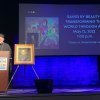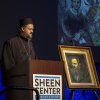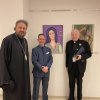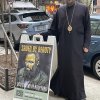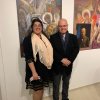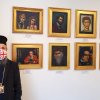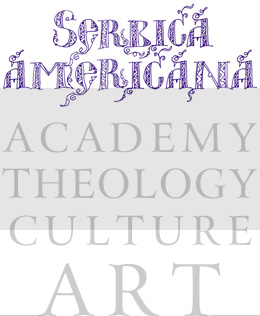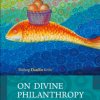The Sheen Center for Thought and Culture in New York City is hosting an exhibit dedicated to the great Russian writer
New York City, April 5, 2022
After all… Dostoevsky belongs in New York!
CATALOGUE (PDF)
The Sheen Center for Thought and Culture in New York City is hosting an exhibit titled “Saved by Beauty: Dostoevsky in New York”. It is a visiual tribute to the 200th anniversary of the birth of Fyodor Dostoevsky (1821-2021) and will last March 18 – April 30, 2022.Having toured Greece and making its New York premiere at The Sheen Center, this exhibit spans two floors and gives visual expression to characters and existential and moral themes from the novels of Fyodor Dostoevsky through a variety of painting styles by 15 artists. Exhibit is featured at the New, Janet Hennessey Dilenschneider Gallery, and it is presented in collaboration with the Greek Orthodox Archdicese of America and St. Sebastian Press of the Western American Diocese, Serbian Orthodox Church.
These beautiful paintings are now welcome in New York, a city that exemplifies in many ways the extreme contradictions and creative struggles that Dostoevsky successfully described in his writings.
The exhibit features art by the Ochre Group: Fr. Stamatis Skliris, George Kordis, Bishop Maxim Vasiljevic, Babis Pylarinos, Costas Lavdas, Maria Panou, Giannoulis Lymperopoulos, Nektarios Mamais, Fotis Varthis, Konstantinos Kougioumtzis, Christos Kechagioglis, Nektarios Stamatelos, Despina Karantani, George Margaritis, Christina Papatheou-Douligeri. And they are all members of the visual group “OCHRE.”“OCHRE” is an informal group of painters, who have contributed to the traditional Orthodox iconography but at the same time are in dialogue with the modern artistic trends.
On April 5, a special presentation on the new international art installation was held at the Loreto Theater, 18 Bleeker Street.In his remarks, read by Archimandrite Nektarios, the Greek Archbishop Elpidophoros said that the title of today’s exhibition uses the past tense to speak of the action of beauty “Saved by Beauty”, however Dostoevsky prefers the future. “Beauty will save the world.” By coming to this Opening tonight, we want to acknowledge the transformative action that beauty and art has had over the world. “Meanwhile, Dostoevsky’s own words resonate like a promise to be fulfilled. The work of beauty as an icon of God’s presence in the world is not over. It has barely started,” concluded the Archbishop.
Bishop Maxim pointed out that the paintings on the walls of the gallery at the Sheen Center show Dostoevsky, a man, dressed in flesh and blood, who lives, suffers, falls, and rises. At the same time, these paintings are a result of a “non-Euclidean” reading of that reality. Fyodor creates art or beauty by confessing what is in his soul, hence its astonishing persuasiveness.Prof. George Kordis spoke about the attempt of “Ochre” group: “We as artists believe that this artistic language, the Byzantine painting system, has elaborated and has developed for centuries in order for the ethos and the spirit of the ecclesiastical life to be properly render in visual terms. For that reason, we believe that this language can serve the needs for expression of contemporary artists who are looking for a vehicle for expressing their spiritual inquiries.”
The exhibit is characterized by great pluralism. It hosts various currents and artistic trends, which are in a harmonious dialogue with each other. One sees Byzantine elements conversing with impressionist, expressionist, cubist, abstract, as well as features of street art, graffiti, etc. The works emit a deep study and understanding of Dostoevsky’s novels. It is very important that the painters have so seriously studied the great writer and philosopher at a time when electronic images and soap operas distract readers from great and essential works and wider Literature. The presentation is immediately followed by a reception at the second floor of the Sheen Center.Given the horrors of the war in the Ukraine, this exhibition reminds the world of its spiritual and cultural inheritance received from the likes of one great Fyodor Dostoyevsky. May it be a blessing to us all!
Read the remarks of Archbishop Elpidophoros, Bishop Maxim and Prof. George Kordis.

